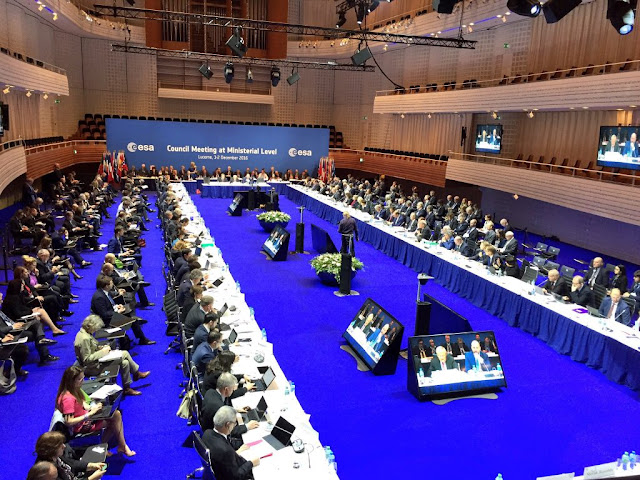By Brian Orlotti
The European Space Agency (ESA), despite rising costs and the recent loss of the Schiaparelli Entry, Descent and Landing Demonstrator Module (EDM), has approved additional funding for a variety of programs, including the second phase of Europe’s ExoMars program, currently scheduled for launch in 2020.
At a December 2nd, 2016 ESA Council meeting in Lucerne, Switzerland, ESA member states agreed to cough up an additional €440Mln EUR ($626Mln CDN) to fund the launch of the ExoMars Rover.
As outlined in the December 2nd, 2016 New Scientist post "ESA approves 2020 ExoMars rover despite crash earlier this year," this rover, the second stage of the €1.3Bln EUR ($1.85Bln CDN) ExoMars program is scheduled to land on the Red Planet in 2021 and drill into the Martian soil to search for traces of microbial life.
Despite the approved increase, ESA’s Director General Johann-Dietrich Wörner emphasized that the ExoMars program is not receiving a ‘blank cheque’ from its members. ExoMars will consume a 1% increase in ESA’s science budget, also agreed to at the meeting.
ESA’s science budget increase dovetails with other funding increases announced at the same meeting:
The recent ESA Council meeting also highlights the ‘tit-for-tat’ nature of government space funding.
In this case, ESA member nations have agreed to prop up the ExoMars program with the expectation that they will receive national contracts in kind for future ESA projects (such as in the ARTES program), in amounts roughly equivalent to the money they've committed.
This is a well understood policy which has served as the core of ESA procurement since its formation in 1975. As outlined on the September 26th, 2007 ESA webpage on "ESA Industry Portal on Industrial Policy and Geographical Distribution," the ESA plan is as follows:
______________________________________________________________
The European Space Agency (ESA), despite rising costs and the recent loss of the Schiaparelli Entry, Descent and Landing Demonstrator Module (EDM), has approved additional funding for a variety of programs, including the second phase of Europe’s ExoMars program, currently scheduled for launch in 2020.
 |
| Nice room. European Union and ESA bureaucrats, PR flacks and scientists gather for the 2016 Ministerial Council, which was held in Lucerne, Switzerland on December 1st - 2nd. As outlined in the December 2nd, 2016 ESA press release, "ESA Ministers Ready ESA for a United States in Europe in the Era of Space 4.0," the increased funding allocated by ESA members during the meeting, "demonstrates once more that ESA’s Member States consider space as a strategic and attractive investment with a particularly high socio-economic value." For more on the ESA's vision, check out the undated ESA web page on "What is Space 4.0." Photo c/o ESA & C. Diener. |
At a December 2nd, 2016 ESA Council meeting in Lucerne, Switzerland, ESA member states agreed to cough up an additional €440Mln EUR ($626Mln CDN) to fund the launch of the ExoMars Rover.
 |
| ESA DG Wörner. Photo c/o DLR. |
Despite the approved increase, ESA’s Director General Johann-Dietrich Wörner emphasized that the ExoMars program is not receiving a ‘blank cheque’ from its members. ExoMars will consume a 1% increase in ESA’s science budget, also agreed to at the meeting.
ESA’s science budget increase dovetails with other funding increases announced at the same meeting:
- ESA’s 22 member states approved €960 million EUR ($1.367Bln CDN) to extend European participation in the International Space Station (ISS) to 2024.
- Canada (ESA’s only non-European member) announced an increased contribution of $83Mln CDN towards various ESA programs, most notably the Advanced Research in Telecommunications Systems (ARTES) program. ARTES is a long-running ESA program supporting the research and development of advanced satellite products and services via public/private partnerships. As outlined in the December 2nd, 2016 Canadian government press release, "Canadian Space Agency strengthens long-term partnership with European Space Agency to support innovation and science," the funds, "in addition to strengthening the long-term partnership with ESA," will also support cutting-edge research and industry growth.
 |
| Nice building. ESA HQ in Paris, France. Established in 1975 and currently with 22 member states (Canada is an associate member) the ESA has a worldwide staff of about 2,000 and an annual budget of about €5.25Bln Euros ($7.48Bln CDN). Photo c/o Jan Woener's blog. |
The recent ESA Council meeting also highlights the ‘tit-for-tat’ nature of government space funding.
In this case, ESA member nations have agreed to prop up the ExoMars program with the expectation that they will receive national contracts in kind for future ESA projects (such as in the ARTES program), in amounts roughly equivalent to the money they've committed.
This is a well understood policy which has served as the core of ESA procurement since its formation in 1975. As outlined on the September 26th, 2007 ESA webpage on "ESA Industry Portal on Industrial Policy and Geographical Distribution," the ESA plan is as follows:
From the outset, the ESA (and its preceding organisations) applied a principle of 'fair return' which has been constantly evolving.
The main rule adopted by the Agency since its Council at Ministerial level in March 1997 is that the ratio between the share of a country in the weighted value of contracts, and its share in the contribution paid to the Agency, must be of X per cent (e.g 0,98%) by the end of a given period.
That ratio is called the industrial return coefficient.The recent Schiaparelli fiasco, if nothing else, proves the old Italian proverb: ‘One hand washes the other.’
 |
| Brian Orlotti. |
Brian Orlotti is a regular contributor to the Commercial Space blog.

No comments:
Post a Comment